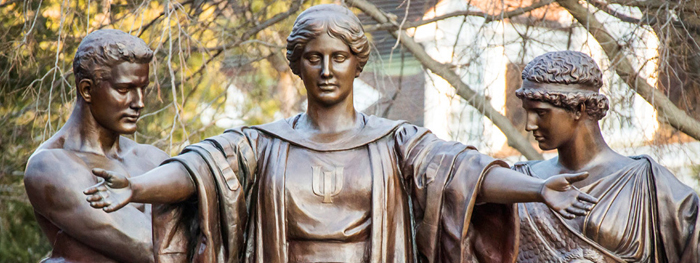The Fun Factor
 Manta roller coaster at SeaWorld in San Diego
Photo courtesy of PGAV
Manta roller coaster at SeaWorld in San Diego
Photo courtesy of PGAV Swum with the dolphins at Discovery Cove in Florida?
PGAV launched that dip.
Thrilled to some of the wilder rides in the roller coaster universe?
Could be PGAV that got you on track.
Come nose-to-nose with a sea lion at the St. Louis Zoo? Cozied up to the penguins? Admired the apes?
All hanging out with help from PGAV.
Destinations big and small, old and new, past and future, local and global – such is the work of PGAV, a St. Louis-based architecture firm co-founded in 1965 by Fred Guyton ’61 FAA (his being the “G” in the name). Over 50 years, the firm has iterated itself into a practice of zoos, theme and water parks, museums, hotels and destination retailers. With $1 billion in project work in 2012 alone, it is one of the largest designers of tourist attractions in the world. The firm even publishes its own research journal, sent to 6,000 managers of attractions (PGAV and non-PGAV alike) around the country and the world; titled Destinology, the quarterly provides data and insights on who goes on vacation and why.
Having a good time is the nut of it, and good times rule where PGAV has had a hand. At the St. Louis Zoo, Sea Lion Sound, a PGAV-designed habitat, features a stunning, transparent tunnel offering visitors a Captain Nemo-eye view of the sleek, bronze mammals as they glide and cavort through their pool. At Dollywood (the Tennessee theme park owned by singer Dolly Parton), PGAV’s award-winning Wild Eagle is the first roller coaster to use a winged design, intensifying the experience of flight with cars that travel alongside the track rather than atop it. From the gift shop at the Arch to PortAventura, a Spanish theme park offering Wild West-inspired rides, the variation across PGAV’s span of projects seems to land, in non-architectural terms, somewhere between impressive and impossible.
Penguins, puffins and simians
While Guyton retired from the firm two years ago, the Illini influence at PGAV endures in the work of architecture grads regularly recruited from the Urbana campus, such as Tony Perkins ’83 FAA, MARCH ’86. Perkins’ portfolio ranges through the sleek expanses of the St. Louis Science Center and Atlanta’s superb Georgia Aquarium to the dolphin hangout that is Discovery Cove in Orlando, Fla., and the St. Louis Zoo, a venerable attraction that blends state-of-the-art animal facilities with vintage buildings and grounds and has been named top zoo in the country by Zagat and Parenting magazine.
Perkins sees his job as uniting the vision of the client and the feasibility of the design. “We have a knowledge base here in the office from past projects that we’ve worked on,” he explains. “And we develop some of our own ideas based on ADA [Americans with Disabilities Act] guidelines. So we have a clear understanding of how those issues and criteria work, in addition
to communicating with the client about their particular, individual goals.”
Such flexibility was especially helpful in 1999 when the penguin and puffin enclosures at the St. Louis Zoo were squawking for improvements and expansion. Ditto for the Fragile Forest, where visitors can get up (pretty) close and personal with orangutans, gorillas and a troupe of other simians. As part of the PGAV team taking on the improvements, Perkins faced a range of challenges from setting refrigeration measures to bird comfort levels to fashioning “rocks” for the gorilla habitat out of concrete, mesh and rebar. One night, not long after completion of a new interior area where zoo-goers could observe the penguins, an adventuresome avian occupant flopped its way over the glass barrier and onto the walkway, to be found there the next morning – well, but unhappy – by the zookeeper.
“You have to learn from the behavior,” Perkins reflects, “and then do things to prevent that sort of thing from happening.”
Elemental realms of design
Perkins has dealt with water a lot over the course of his career with PGAV, such as expanding the Georgia Aquarium in Atlanta, a transcendent space where enormous sheer walls give the feeling of being in the ocean with sharks, rays, whales and a host of other sea creatures. Perkins describes this as an “immersive environment. … You’re not just gazing at the animal or the exhibit, you’re participating. It becomes interactive.”
“That’s what we try to do in a lot of our exhibits.”
For Perkins’ colleague, Emily Bandre Pelcak ’01 FAA MARCH ’03, PGAV has meant water immersion of a different kind. Shortly after the firm hired her in 2004, she went to work on the prototype for Aquatica, a SeaWorld water park addition that debuted at the Orlando, Fla., location (and has since been replicated at the other SeaWorld locations in San Diego and San Antonio). Almost immediately, “I got into the design and the fun,” she recalls, “choosing characters that are going to be the spokesperson for the water park and helping design the general character of the park.”
PGAV also has a lot to do with air – literally, as in flying through it on roller coasters of which the firm has designed 30 to date. Perkins worked on Montu, which opened at Busch Gardens in Tampa, Fla., in 1996 as the world’s tallest and fastest inverted roller coaster at the time. Pelcak has been involved in the construction of Manta, with a look inspired by the manta ray, at the San Diego SeaWorld, and in the design of Verbolten at Busch Gardens in Williamsburg, Va., the first roller coaster in North America with a full-train gravity drop – meaning that all of the cars are in free fall during one brief and incandescent section of the ride.
Creating a roller coaster involves design, materials testing and even storyboarding. “We come up with an initial layout – ‘we want to go upside down here, we want to turn here, we want it to be a top rider or a low rider’ – and then we’ll work with the engineer to make that happen,” Pelcak explains. “And, of course, if we’ve violated the laws of physics, somewhere early on they
fix it for us.” Before the roller coaster goes live it goes virtual, with a 3-D model provided by the coaster’s manufacturer, “where you can sit on a train, virtually, and ride the ride,” Pelcak says.
“So, that’s cool.”
A different kind of signature project for Pelcak has been at the Biltmore estate, a mansion on 8,000 acres owned by the Vanderbilt family in the mountains of North Carolina and open to tourists. Pelcak helped create Antler Hill Village, a retail gateway area offering visitors refreshments and historical background. “We got to work with the archivist on understanding the history and also work with the two descendants who run the estate now and learn how they’re carrying on that historic tradition,” she says. So enamored was Pelcak of the setting – and so proud of her work there – that she got married on the Biltmore grounds in 2011 to fellow PGAV architect Brian Pelcak.
A home overlooking the Arch
The PGAV story is intimately bound to that of its home city of St. Louis, where founder Guyton and his PGAV partner Fred Walton became involved in rehabbing – and helping rescue – the downtown in the ’60s and ’70s. The transformation endures, particularly along Washington Avenue, where once-defunct buildings and warehouses were reborn into a vibrant commercial district. Most of the firm’s practice is devoted to its destinations group (residences and commercial buildings are designed by a PGAV group housed across the state in Kansas City). But the tradition of revitalizing historic buildings and districts continues in the planning group, of which Andrew Murray, MUP ’05, is part. Funded by historic tax credits and other forms of local and state support to improve downtowns and grow tax bases, the group has helped transform communities all over Missouri and Illinois, including the theater district in Chicago’s Loop. Murray, who joined PGAV two years ago, works with small towns “to help them get the downtown to come back, reinvest, use investment that’s already there and put it to good use.”
A commitment to downtown is also explicit in PGAV headquarters, located in a 1983 brick office tower that the firm designed and that overlooks the Arch. Located on the 10th floor, the PGAV suite houses a collection of collaborative spaces, where desks and drafting tables cluster in U-shaped areas, each occupied by a team, each team coming together for a specific project on a specific timeline.
Worldwide boundaries
The other deep connection between St. Louis and PGAV lies 10 miles or so to the west on the campus of Anheuser-Busch. Architecture firm and brewery have grown together in projects that range from functional buildings at A-B corporate headquarters to Busch Gardens and SeaWorld theme parks.
But for PGAV, the boundaries bent wider long ago to expand worldwide. Architecture for Universal Studios in Orlando. Visitor centers at Niagara Falls, the Grand Canyon and Mark Twain’s boyhood home on the Mississippi River. Hotels and resorts, as well as theme and water parks across the nation. Awards, too. When the Louisville zoo was honored last winter for Glacier Run – a habitat that houses polar bears – the honor came for work by PGAV.
Today, the firm’s horizons extend farther than ever, from enhancement of the National Underground Railroad Freedom Center in Cincinnati to designing part of the space shuttle Atlantis exhibit at Kennedy Space Center to creating Chimelong Hengqin Ocean Kingdom, an enormous marine park in China. All are set to open within the year.
Noting that the imprint of PGAV is “everywhere you go in St. Louis and all over the biggest destination cities around the world,” Ben Cober ’07 AHS observes that not only are PGAV projects “really eye-catching and beautiful – they’re incredibly, brilliantly functional.”
“These are projects that are keeping animals alive, that are generating electricity, that have water flowing through them,” says Cober, who serves as director of business development and research at PGAV.
PGAV accountant Jim Duckwitz ’99 BUS, who joined the firm seven years ago, says that even in the back office, “There’s always something new and unique we’re working on.
“I took my daughter to Sea Lion Sound, and she was just barely 2,” he recalls. “To see that sea lion’s face right by yours is – especially for a little kid – that’s pretty cool. That’s pretty magical. And a little scary, maybe.”
Cool and a little scary, maybe. That’s PGAV.

